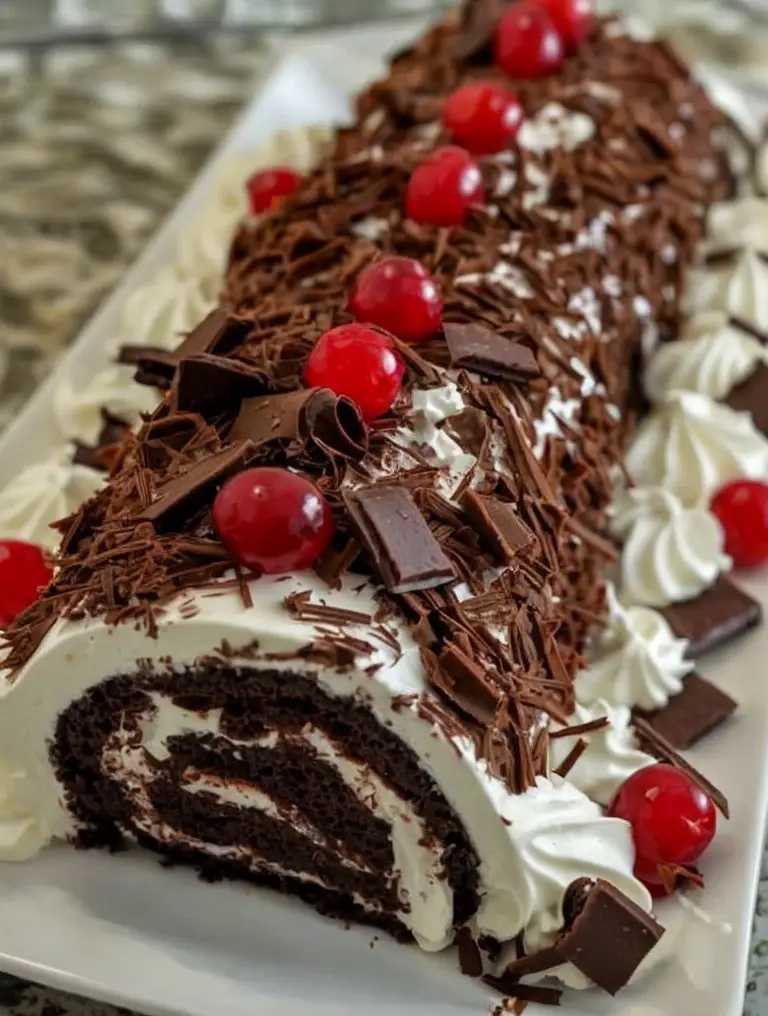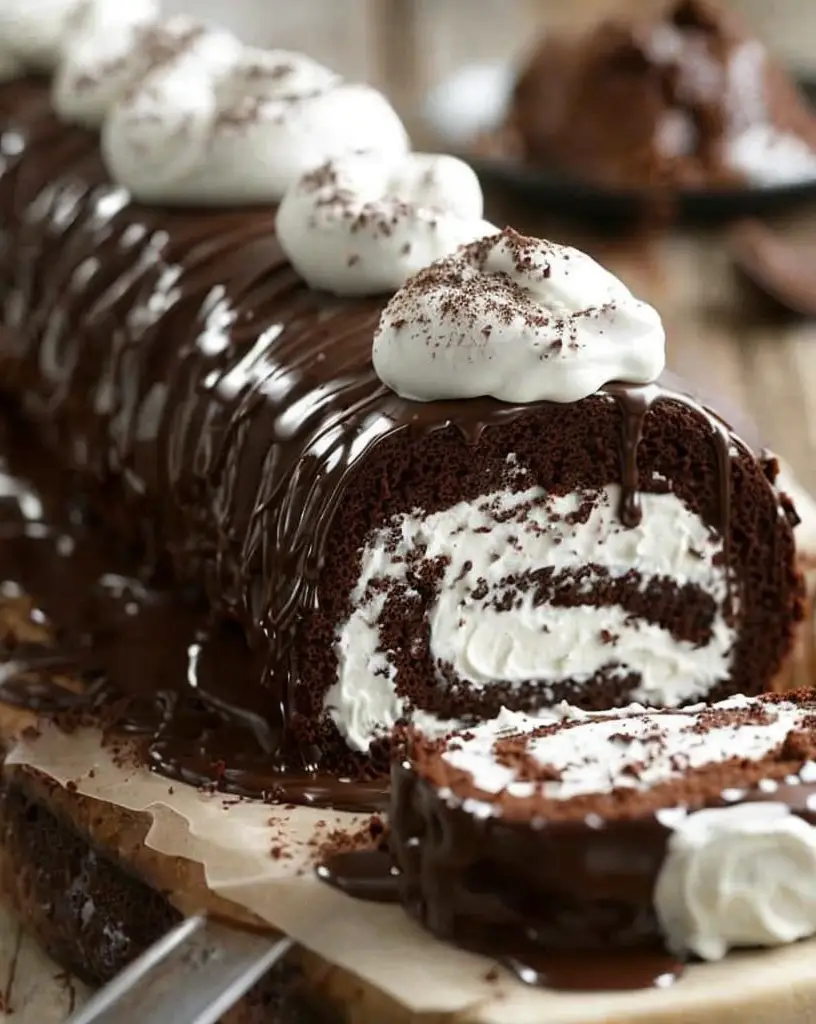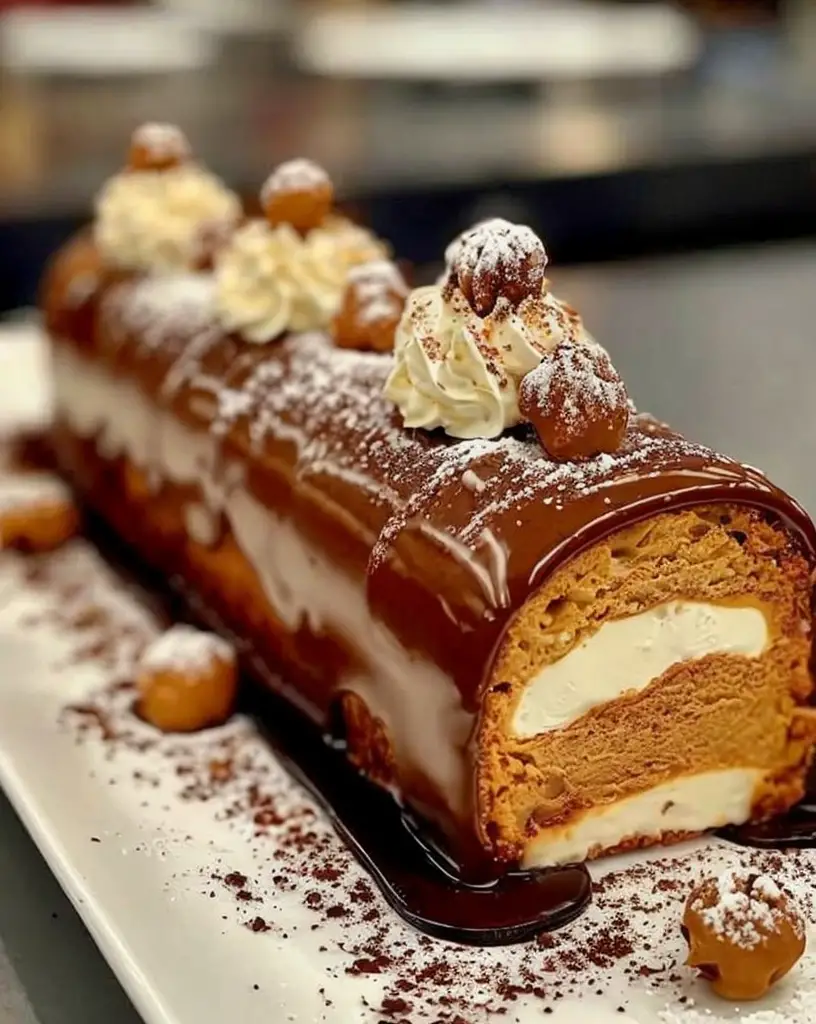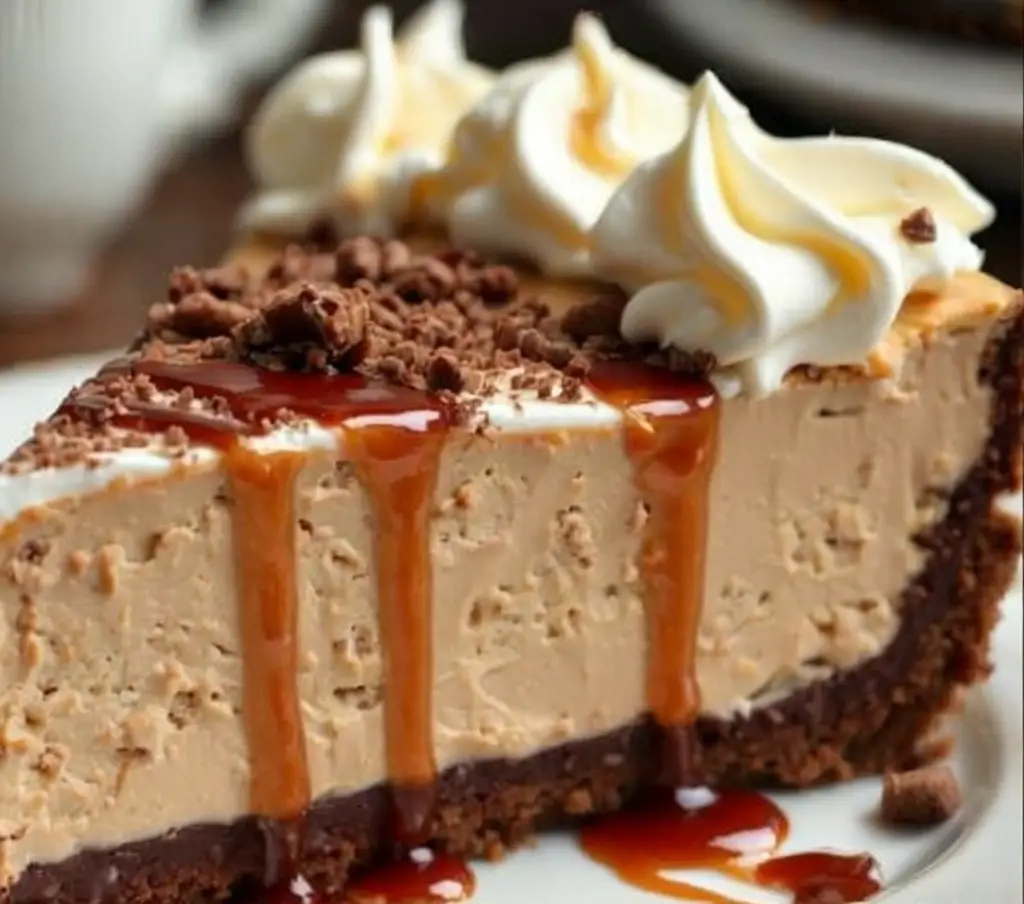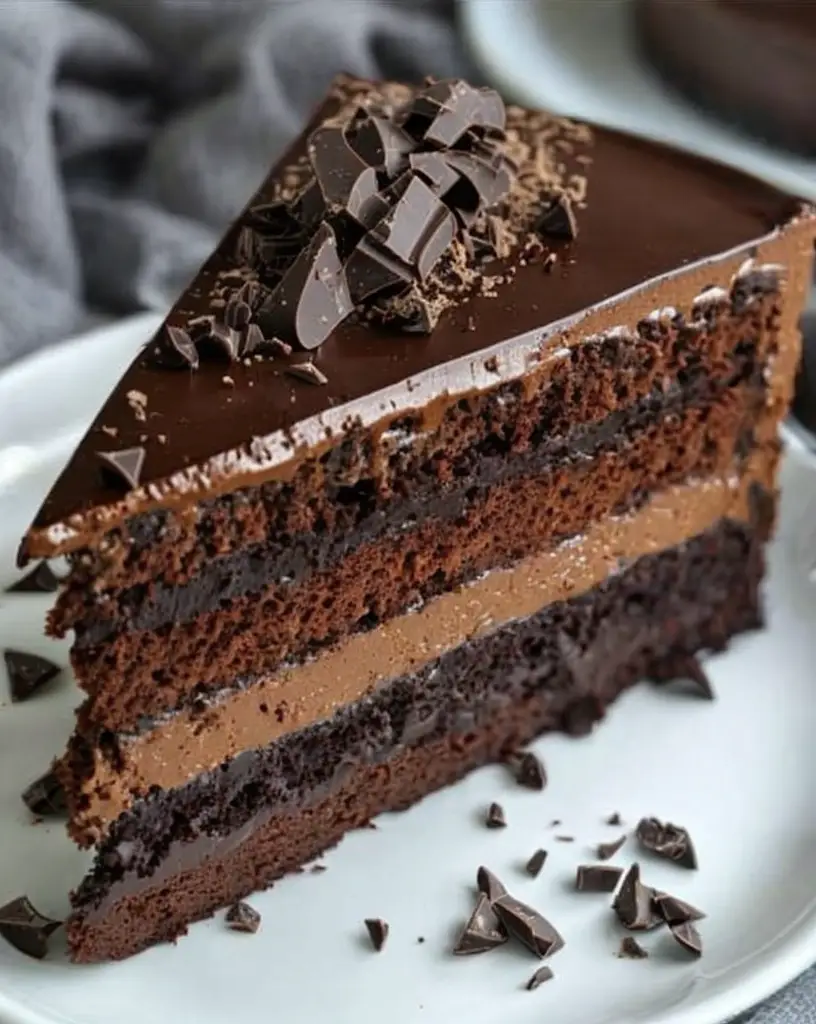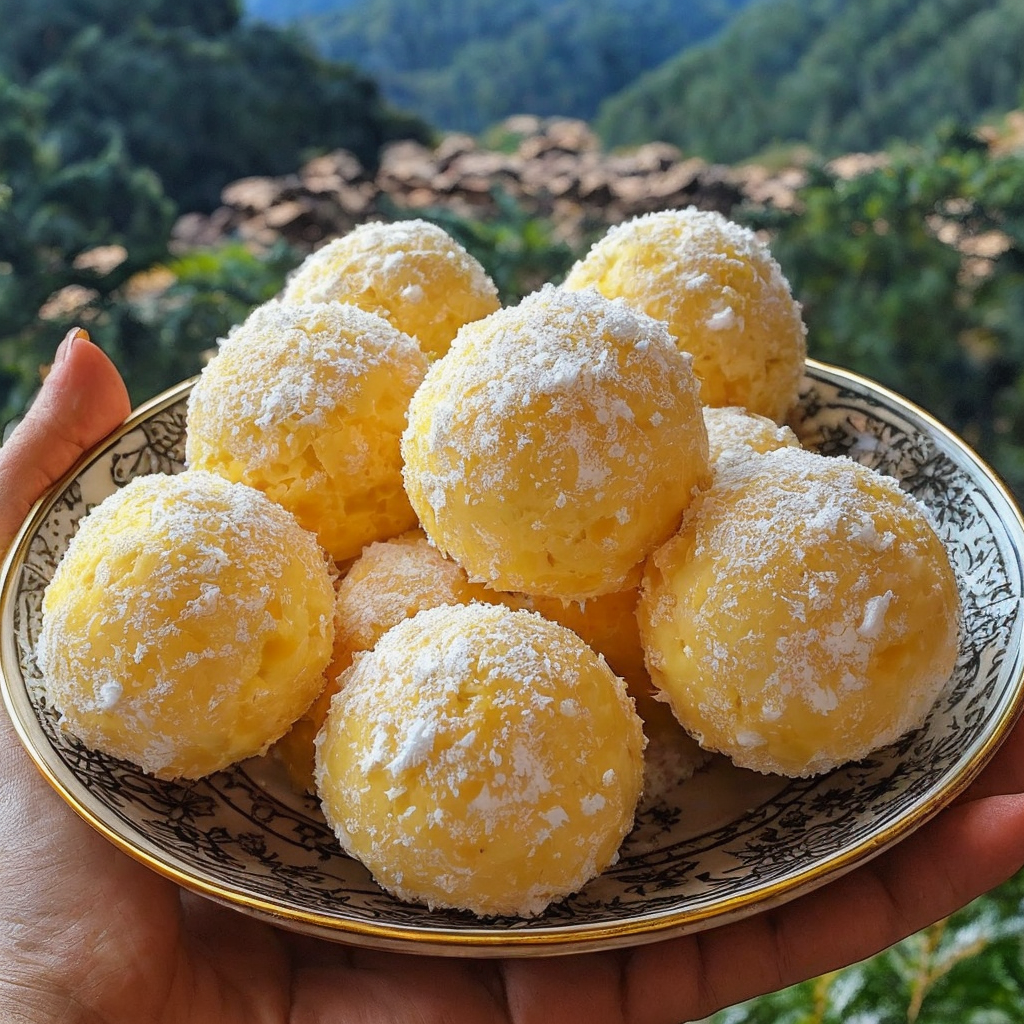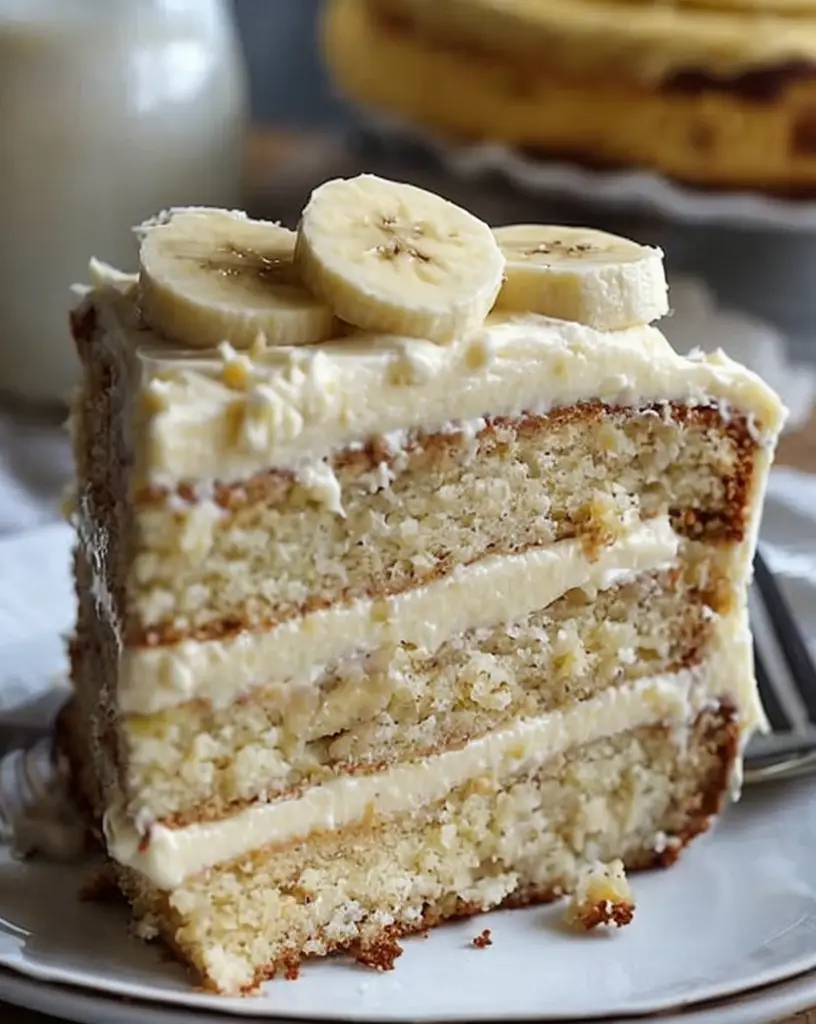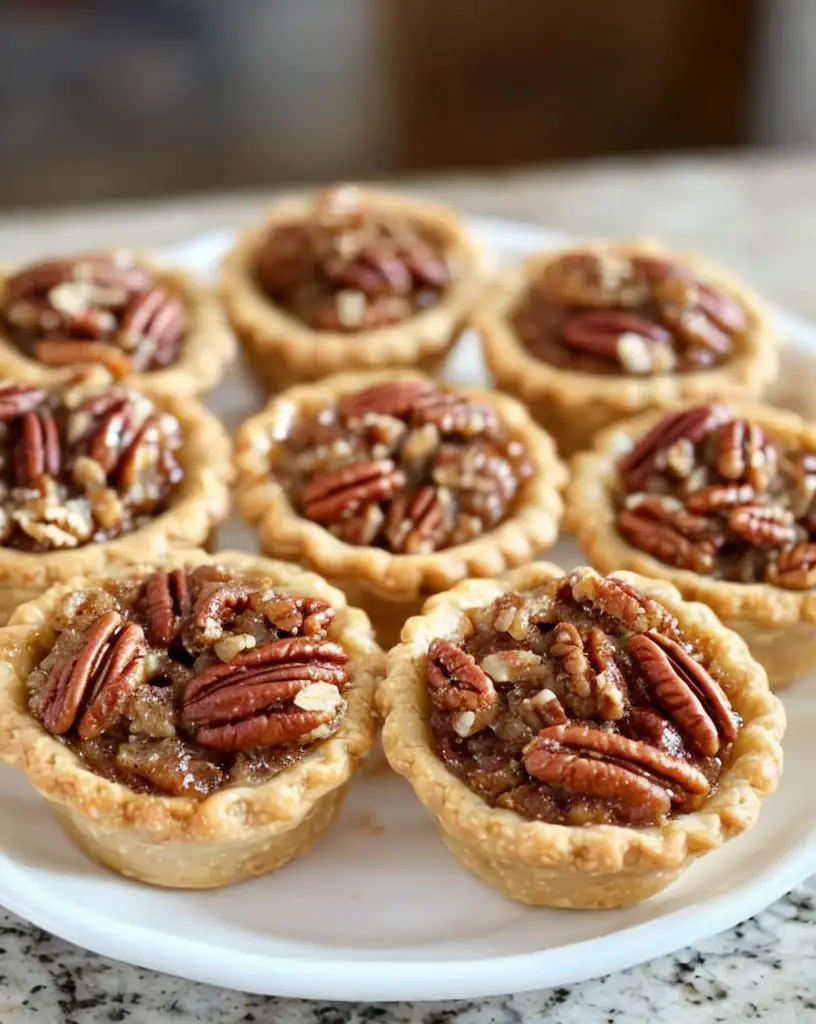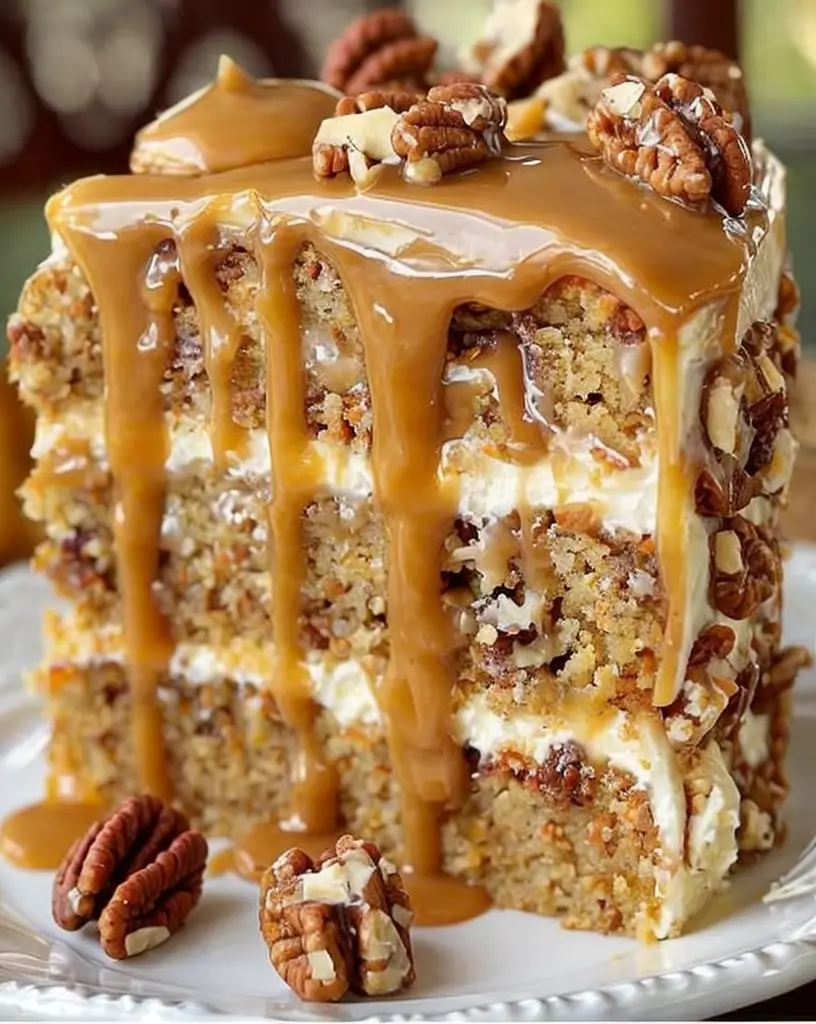German Black Forest Swiss Roll: A Decadent Delight
Indulge in the rich and flavorful experience of a German Black Forest Swiss Roll, a dessert that marries the bold taste of dark chocolate with the sweet and tangy notes of cherries. This scrumptious treat is perfect for any occasion, bringing a touch of European elegance to your dessert table. Whether you’re sharing it with family or savoring a slice alone, the German Black Forest Swiss Roll offers a delightful blend of textures and flavors that will leave you longing for more.
Experience the joy of creating this German specialty right in your kitchen. The moist chocolate sponge cake, paired with luscious whipped cream and an indulgent cherry filling, offers a well-balanced harmony of sweetness and richness. This delectable roll is not just a feast for the taste buds, but a visual masterpiece, with its striking layers and intricate design. Every bite is a testament to its traditional roots, yet its appeal is timeless, making it a favorite across generations.
If you’re seeking to expand your baking repertoire, the German Black Forest Swiss Roll is an excellent choice. While it may seem complex, with careful attention to each step, even novice bakers can achieve success. With its impressive appearance and irresistible flavor, this dessert is a guaranteed crowd-pleaser. So, why wait? Embrace the art of German baking and surprise your loved ones with this exquisite Swiss Roll.
Quick Recipe Highlights
- Flavor Profile: The German Black Forest Swiss Roll features a deep, chocolatey base that perfectly complements the sweet and tart cherry filling, creating a harmonious balance of flavors.
- Texture: Experience a delightful contrast between the soft, sponge-like cake and the smooth, creamy whipped cream filling, accented by the juicy burst of cherries.
- Aroma: The enticing scent of dark chocolate mingles with the sweet, fruity fragrance of cherries, enveloping your senses in a delightful aroma.
- Visual Appeal: With its striking layers of rich chocolate, vivid cherries, and whipped cream, this roll is a showstopper, offering an elegant and inviting presentation.
- Skill Level Needed: Mastery of rolling techniques and careful timing is essential, but with practice, even aspiring bakers can achieve perfection.
- Special Equipment: A jelly roll pan and parchment paper are essential for creating the perfect Swiss Roll, ensuring even baking and easy rolling.
Recipe Overview
- Difficulty Level: Choosing a medium difficulty level is apt, as it involves multiple steps, including creating the batter, precise baking, and skillful rolling. However, with attention and patience, the process is quite manageable.
- Category: This recipe falls under the dessert category, offering a sweet finish to meals and an indulgent treat during tea time or festive celebrations.
- Cuisine: Rooted in traditional German cuisine, this roll is inspired by the well-loved Black Forest cake, a staple in German confectionery known for its distinct taste and rich heritage.
- Cost: The components include common pantry items and a few special ingredients like cherries, making it moderately priced and accessible, particularly when cherries are in season.
- Season: Ideal for late spring through summer when cherries are at their peak, yet perfect for colder months when a rich, comforting dessert is desired.
- Occasion: The German Black Forest Swiss Roll suits a variety of occasions, from festive gatherings and birthdays to casual family dinners or as a special weekend treat.
Why You’ll Love This Recipe
Delight in the exquisite taste and texture of the German Black Forest Swiss Roll, where each bite offers a perfect harmony of rich chocolate and tangy cherries. The complex layers of flavors meld together seamlessly, creating a dessert that is both indulgent and satisfying. The velvety whipped cream enhances the experience, ensuring a smooth and luxurious mouthfeel that is hard to resist. Whether you’re treating yourself or impressing guests, this recipe’s flavor profile is sure to captivate.
In terms of convenience, the Swiss roll is surprisingly straightforward to prepare once you master the rolling technique. With a total preparation and cooking time of under an hour, it offers a quick turnaround for a dessert of its caliber. The use of accessible ingredients makes it a feasible option for any home cook looking to try their hand at something special without significant hassle or stress.
For those conscious of nutritional balance, this dessert provides moderate indulgence. While it is indeed a treat, the inclusion of fresh cherries offers a dose of vitamins and antioxidants. Meanwhile, the use of dark chocolate can bring some health benefits, like improved heart health when enjoyed in moderation, making it not just a tasty choice but a smart one as well.
Bring joy to your social gatherings with this crowd-pleaser. Its universal appeal to both young and old makes it an excellent choice for social events, ensuring smiles and satisfied palates. The German Black Forest Swiss Roll becomes more than just a dish—it’s a centerpiece that sparks conversation and creates memories during holidays and family occasions.
From a cost perspective, this delicacy is quite economical, leveraging a few staple ingredients from your pantry with some special additions. When cherries are in peak season, the cost-effectiveness increases, giving you more dessert for your dollar. Its affordability combined with its rich taste makes it a favorite for both budget-conscious bakers and those seeking luxurious flavors.
Historical Background and Cultural Significance
The origins of the German Black Forest Swiss Roll draw from the renowned Black Forest cake, named for the Black Forest region in Germany. While precise historical accounts vary, the roll’s development was a natural evolution, adapting the cake into a more portable and visually striking dessert. This specific adaptation of rolling the cake to encase its fillings added a new dimension to enjoying traditional flavors, widely embraced across Europe by the late 19th century.
Culturally, the Black Forest is a region steeped in rich folklore and tradition, lending its name to one of the most beloved desserts worldwide—Schwarzwälder Kirschtorte. The Swiss roll version, while a less formal interpretation, carries its own significance as a testament to German baking ingenuity. It’s a means of sharing intricate flavors in a modern, convenient form, appreciated at both everyday tables and grand celebrations.
Over the years, the German Black Forest Swiss Roll has seen numerous adaptations, reflecting changes in culinary tastes and ingredient availability. Originally prepared with the region’s iconic Kirschwasser, a cherry brandy, the roll now often opts for more accessible cherry fillings and whipped cream to cater to broader palates. These changes illustrate the global influence and adaptation of German culinary traditions.
Regional variations of the Swiss roll also capture unique interpretations, from added chocolate shavings and cherry juice to whiskey-infused cream or alternate fruit fillings, demonstrating its flexibility and enduring popularity. Each version honors the essence of the Black Forest while allowing for personalization, ensuring its place in the culinary spotlight worldwide.
Ingredient Deep Dive
Cherries, the heart of this Swiss roll, are more than just a flavorful addition; they hold cultural significance as a symbol of prosperity and friendship in many traditions. Historically cherished in European cuisines, cherries offer vibrant color and a burst of sweetness in this dessert. Beyond aesthetics, they are packed with antioxidants, vitamins, and numerous health benefits such as reducing inflammation and promoting heart health.
When selecting cherries for your German Black Forest Swiss Roll, fresh, plump, deep red ones with shiny skins are best, providing the most intense flavor and visual appeal. If fresh are unavailable, frozen or canned cherries can serve as suitable alternatives. Store fresh cherries in the refrigerator and consume them within a few days for maximum flavor. For substitutions, consider using other tart fruits like raspberries or plum slices for a new twist.
The central ingredient, chocolate, offers more than its recognizable richness—it is woven into the fabric of culinary history, symbolizing decadence and celebration. In addition to delivering a deep, satisfying taste, quality dark chocolate also contributes to health benefits like antioxidant properties and mood enhancement. Choosing a chocolate of at least 70% cocoa ensures a robust flavor and a bittersweet balance essential for this dessert.
Preserve your chocolate’s quality by storing it in a cool, dry place away from sunlight, rather than the refrigerator, which can cause it to develop a white film and affect texture. If substitutions are necessary, quality cocoa powder combined with a touch of melted butter can mimic chocolate’s richness in the cake, ensuring the Swiss roll maintains its signature, delicious character.
Common Mistakes to Avoid
- Overbaking the sponge results in a dry cake and cracks when rolling. Keep a watchful eye on it and remove once it springs back to touch.
- Skipping the parchment paper can lead to the cake sticking and tearing. Ensure you line the pan well before pouring in the batter.
- Filling the roll while the cake is hot may cause the cream to melt. Let the sponge cool slightly before spreading your fillings.
- Using low-quality chocolate reduces the dessert’s richness. Opt for high-quality dark chocolate for authentic flavor.
- Rolling the cake too tightly might squeeze out the cream, leaving an uneven filling. Roll gently and evenly for best results.
- Overloading on filling makes it difficult to roll and can cause tearing. Spread a moderate, even layer.
- Failing to whip the cream to the right consistency can result in a runny filling. Beat until stiff peaks form for structure.
- Neglecting to dust the surface with cocoa powder can result in a sticky, unattractive finish. Lightly dust before serving for presentation.
- Ignoring temperature when storing may cause the roll to dry out. Wrap well and refrigerate, consuming within two days.
- Not following precise measurements can unbalance flavors. Stick to the precise weights and measures for a successful bake.
Essential Techniques
The technique of rolling the cake is vital for a successful presentation and even filling distribution. This step requires finesse and patience. Start by using a clean, lightly sugared kitchen towel, and gently guide the sponge into its roll while it’s still slightly warm to prevent cracking. Watch for signs of tearing and adjust your pressure to maintain an even roll. Mastery of this skill ensures a stunning final product every time.
Chocolate ganache as a finish provides a velvety texture and rich taste that enhances the dessert. Creating ganache involves carefully melting chocolate with cream to a smooth consistency. Keep heat low and steady to prevent burning the chocolate, stirring constantly to blend both ingredients seamlessly. Ganache adds an extra layer of sophistication, turning your Swiss roll into a lavish masterpiece.
Whipping cream to the perfect consistency is crucial for the lightness of the filling. Start with cold cream and chill the mixing bowl and beaters for best results. Beat on medium speed, watching for soft peaks to firm up into a stable consistency. Avoid over-whipping to prevent a grainy texture; stop once stiff peaks form, offering the ideal blend of stability and smoothness.
Using fresh cherries provides the brightest flavor, but preparing them is key. Properly washing, pitting, and slicing your cherries ensures they integrate beautifully into the roll without overwhelming the batter. Incorporate them evenly throughout the filling mixture to maintain a consistent taste and texture across each slice of your Swiss roll.
Pro Tips for Perfect German Black Forest Swiss Roll
Bring your eggs to room temperature before starting your batter. Room temperature eggs will mix more smoothly, allowing for a more even sponge texture that is vital for rolling.
For extra cherry flavor, consider soaking fresh cherries in a little Kirsch or cherry juice before incorporation. This infusion deepens the flavor profile, enhancing the signature taste of this dessert.
Prepare your jelly roll pan by lining it with parchment paper, allowing an extra overhang on the sides. This approach ensures a seamless release of the sponge, reducing frustration and improving results.
Gently fold the flour into your sponge mixture, taking care not to overmix. Preserving the airiness of the batter is crucial for achieving a light and fluffy cake, which rolls easily and without cracking.
If time allows, chill the roll briefly after filling it. This helps the cream set, making slicing and serving much neater while maintaining the roll’s structural integrity.
A light dusting of powdered sugar or cocoa atop adds a touch of elegance and prevents sticking when covering your finished roll with plastic wrap for storage.
Offer a contrast in your whipped cream by adding a hint of vanilla or a spoonful of cherry juice. These subtle accent flavors can elevate the complexity and delight of each bite, impressing even the most discerning palates.
While cherries are essential, you can introduce chopped chocolate pieces within the filling for a unique twist on texture, offering both a visual surprise and a flavor enhancement.
Variations and Adaptations
Explore regional variations by swapping in sour cherries or adding a splash of Kirsch to intensify the German origins of the dish. Each substitution alters the flavor profile slightly, allowing for broad customization while remaining true to the roll’s roots. You might even discover a new favorite flavor combination in the process.
For a seasonal adaptation, consider using raspberries or strawberries in place of cherries during late summer or early autumn. These fruits bring a uniquely fresh sweetness while complementing the chocolate base, offering a vibrant and refreshing palate change.
To modify the recipe for dietary needs, experiment with gluten-free flours or use a dairy-free cream alternative for the filling. These changes ensure everyone can enjoy the dessert, regardless of dietary restrictions, while maintaining its renowned taste and appeal.
Add an exotic twist by incorporating cardamom or cinnamon into the chocolate sponge. These spices introduce warmth and complexity, making the Swiss Roll uniquely your own while preserving its essential decadent nature.
Texture modifications can be made by adding layers of crunchy nuts or a light drizzle of syrup atop the roll before serving. These alterations not only enhance texture but also add a visual flair, transforming the dessert into a showpiece suitable for photo-worthy presentations.
Serve your Swiss Roll with fresh berries or mint leaves as garnish to elevate the presentation. For a modern twist, slice the roll into mini portions for individual servings, perfect for elegant tea parties or intimate gatherings, offering a touch of class and finesse to your table settings.
Serving and Presentation Guide
Use a sharp serrated knife to slice the roll cleanly, revealing the layers within that are sure to impress. Present each slice on a distinct dessert plate, lightly dusted with cocoa or confectioner’s sugar, to accentuate the roll’s rich tones.
Garnish the plate with whole cherries, a drizzle of chocolate or cherry sauce, and a sprig of mint to enhance visual appeal and provide balance in flavors. These additions also give the dessert a refined look, elevating even the simplest setting.
For traditional accompaniments, offer a dollop of fresh whipped cream or a scoop of vanilla ice cream beside each slice. Their mildness pairs perfectly with the intense flavors of the roll, enhancing the overall tasting experience without overshadowing the Swiss Roll’s natural richness.
Contemporary serving suggestions include layering your roll slices over a bed of fruit coulis or yogurt, offering a new dimension of flavor while encouraging diners to explore new combinations.
Consider the temperature of the roll when serving; slightly chilled maintains its shape, while allowing the flavors to mingle as they warm on the tongue. This balance is essential for showcasing the roll’s contrast between rich and tart components.
For portion control tips, make sure to offer modest slice sizes, as the intense flavors and rich components can easily satisfy even the most substantial sweet tooth in small quantities. This approach helps manage indulgences while allowing guests to savor every bite.
Wine and Beverage Pairing
A classic wine pairing with the German Black Forest Swiss Roll is a late harvest Riesling. The wine’s sweet and slightly acidic profile complements the rich chocolate, enhancing the cherries’ natural tartness, creating a harmonious dining experience.
For non-alcoholic alternatives, serve with a freshly prepared cherry or raspberry iced tea. These beverages mirror the Swiss Roll’s fruity elements, providing a refreshing counterpoint to its richness without overpowering your palate.
Coffee is a classic companion to chocolate desserts. Pair with a robust, medium-roast coffee to highlight the roll’s depth, or offer a delicate, floral tea for a lighter refreshment that won’t compete with the bold flavors.
Serve beer such as a cherry lambic for an unconventional choice. Its tartness plays well with the roll’s cherry filling, engaging your tastebuds in an unexpected yet delightful way, appealing to adventurous diners.
Temperature considerations are key to enhancing these beverage pairings. Serve cold drinks lightly chilled, retaining their refreshing qualities, while offering coffee and teas freshly brewed and piping hot to contrast the dessert’s subtle sweetness.
For additional serving suggestions, keep glass garnishes subtle, such as a simple lemon twist or a sugared rim, to enhance without distracting from the drinks’ natural qualities and the Swiss Roll’s indulgent flavors.
Storage and Shelf Life
Proper storage ensures your Swiss Roll remains fresh and delicious over a couple of days. After serving, wrap the roll tightly with plastic wrap or store in an airtight container to prevent drying out, maintaining its moisture and freshness.
Refrigerate the dessert promptly, ensuring a consistent cool temperature of about 36 to 40°F (2 to 4°C) to extend its lifespan. While refrigeration is essential, avoid storage in areas of the fridge subject to drastic temperature changes, like the door.
For optimal storage conditions, use containers that are just slightly larger than the roll to prevent excessive air exposure, helping maintain the dessert’s moisture level and ensuring flavors remain intact.
Signs of spoilage include an off-smell, stale texture, or any visible mold growth, at which point the roll should be discarded for safety reasons, preventing consumption of spoiled food.
Reheating is typically unnecessary, as the roll is ideally enjoyed at room temperature or slightly chilled. However, if considering warming parts like the chocolate dressing before serving, do so gently over a bain-marie to prevent overheating.
While freezing may not be the best option due to potential changes in the texture of the whipped cream, if necessary, freeze slices individually wrapped and consume within a couple of weeks for best results.
Make Ahead Strategies
Creating portions of this dessert ahead of time improves time management and ensures focus during final assembly. Prepare your sponge cake and freeze, wrapped securely in parchment and plastic wrap for extended storage up to a month ahead of the event.
During the prep timeline, assemble your whipped cream and cherry filling a day in advance, chilling in airtight containers. This prep maintains their freshness and ensures a streamlined process on the day of assembly.
Between steps, particularly once filled and rolled, chilling the dessert briefly allows the flavors to meld and firm up, while reducing the risk of runny cream or uneven slices during serving.
Assess the potential quality impact of storage by sampling small test portions after refrigeration, adjusting your techniques or ingredient proportions as needed for subsequent creations to ensure the best possible outcome.
When assembling, ensure a gentle hand is used when rolling, capitalizing on the pre-chilled status of the components to facilitate smooth movement and prevent tearing during the process.
Finally, add fresh elements like garnishes immediately before serving to enhance presentation and provide a burst of flavor, ensuring the final result pleases both the eyes and mouth.
Scaling Instructions
When halving the recipe, adjust ingredient measurements proportionally, ensuring harmony between the reduced component parts for consistent taste and texture. Embrace smaller pans for baking to maintain sponge thickness suitable for rolling.
Doubling or tripling the recipe is straightforward by maintaining ingredient ratios, though one should ensure the use of a larger mixing bowl and sufficient larger baking trays to handle increased batter volumes without spillage.
Avoid overcrowding the oven, adjusting equipment placement for even heat distribution across multiple Swiss Rolls, and slightly extending baking time to accommodate temperature core variations in larger cakes.
Timing modifications are crucial; longer cooling times may be necessary for larger batches, while assembly should still follow within a tight framework, preventing melting or mishaps during rollout.
Scaling considerations also focus on storage space, with multiple rolls requiring adequate chilling room or containers to ensure all portions maintain freshness and structure before the time of serving.
If the expansion is for a grand event or catering, consider preparing batch components like whipped cream or cherry garnish in advance to streamline the process and ensure efficient assembly and presentation.
Nutritional Deep Dive
A macro breakdown analysis of the German Black Forest Swiss Roll highlights the balance between carbohydrates from sugar and flour, fats from cream, and proteins from eggs, creating a well-rounded indulgence.
In terms of micronutrient contribution, the cherries provide a wealth of vitamins A and C alongside antioxidants, complemented by the presence of iron and magnesium from quality dark chocolate.
With health benefits in mind, responsible enjoyment is encouraged, given its diverse ingredients that can contribute to improved mood, cardiovascular health, and reduced inflammation effects due to antioxidant content in moderation.
Dietary considerations suggest moderation; as such, portions should be reasonable to enjoy the flavors without excess calorie intake. A combination of smaller serving size and savoring each bite ensures satisfaction with less consumption.
For a more thorough portion analysis, smaller slices offer a guilt-free way to indulge in this delicious German treat, balancing pleasure and dietary control while still presenting an attractive, popular offering.
In weight management contexts, consider servings as shared indulgences, promoting social engagement and shared responsibility, reducing the temptation to consume in isolation, helping manage caloric intake effectively.
Dietary Adaptations
For a gluten-free adaptation, substitute traditional wheat flour with a high-quality gluten-free blend. Ensure it includes xanthan gum or similar thickeners to replicate the sponge texture required for successful rolling.
Achieving a dairy-free version involves replacing whipped cream with a coconut-based or other plant-based alternative, carefully chosen to retain the Swiss Roll’s signature creaminess without compromising on flavor or presentation.
Opting for a vegan variation would require plant-based egg substitutes such as aquafaba or flaxseeds, alongside vegan chocolate and cream alternatives to maintain flavor integrity without utilizing animal products.
Low-carb modifications can be made by experimenting with sugar replacements like erythritol and low-carb flour substitutions such as almond flour, effectively reducing carbohydrate content without sacrificing taste.
For sophisticated keto adjustments, apply a combination of nut flours and stevia to cater seamlessly to specific dietary needs, enabling keto-practicing guests to indulge in this tempting treat guilt-free.
Similarly, Paleo enthusiasts can enjoy a version aligned with their diet using raw chocolate, almond flour, and honey for sweetening, transforming it into a naturally sourced, diet-compatible indulgence.
Those following a low-FODMAP diet can replace cherries with a low-FODMAP fruit like kiwi for a safe substitution, ensuring the Swiss Roll remains an accessible and delicious option for everyone.
Consider any other specific dietary accommodations by closely analyzing ingredient compatibility before implementation to ensure successful taste preservation and dietary suitability.
Troubleshooting Guide
Address texture issues in sponge by reviewing mixing technique—overmixing or underbaking leads to undesirable results. Achieve fluffy consistency by gentle folding and precise baking times.
Balance flavor by ensuring proper cherry distribution and chocolate enhancement. Taste test fillings beforehand to adjust sweetness levels perfectly, keeping an eye on proportions for ideal taste harmony.
Combat temperature problems by maintaining consistent oven heat and preheating thoroughly. Consider using an oven thermometer for accurate monitoring and reliable baking results to prevent undercooking.
Overcome equipment challenges by ensuring the right size tools, such as pans and mixing bowls, to match recipe volume. This preparation prevents unnecessary spills or failed bakes due to overcrowding.
Ingredient substitutions should focus on maintaining texture and flavor balance, choosing alternatives with similar properties and hydration levels to preserve the Swiss Roll’s known quality characteristics.
Solve timing concerns by accurately tracking all stages; use timers or apps for reminders equivalent to task durations, thereby ensuring successful completion of steps without rushing or delay.
Recipe Success Stories
Community feedback highlights the German Black Forest Swiss Roll as a stunning centerpiece at both intimate celebrations and grand gatherings, winning accolades for taste presentation, and adding a gourmet touch to events.
Discover variation successes as bakers worldwide iterate with local fruits or infusions, sharing stories of how they made the recipe their own. These shared adaptations encourage creativity and cross-cultural flavor explorations.
Adaptation stories often include heartfelt accounts of ingredient swaps related to allergy accommodations or cultural influences, enhancing the Swiss Roll’s universal appeal while embracing individual dietary needs.
Reader suggestions introduce delightful innovations like personalized cream flavors or expanded layers, ushering in fresh perspectives on presentation and composition while maintaining traditional recipe integrity.
Photography tips range from lighting advice to innovative plating techniques, inspiring fellow bloggers or Instagram enthusiasts to document gorgeous creations, showcasing the Swiss Roll’s aesthetic potential beautifully.
Frequently Asked Questions
What cherries work best for this recipe? Fresh sour cherries are traditional but sweet or dark cherries can also yield excellent results. Adjustments in sugar may be necessary to balance sweetness levels.
What is the shelf life of a Swiss Roll? Ideally, consume within 2-3 days. Proper storage in airtight conditions and consistent refrigeration preserve its freshness and flavor during this timeframe.
Can I use canned cherries? Absolutely, ensure they are well-drained before use to avoid excess moisture in the roll. This ensures the roll maintains its stiffness and doesn’t become soggy.
How do I prevent my roll from cracking? Roll the sponge while slightly warm using parchment for guidance. If cooled, a brief microwave inner softening step can aid in gentle formation without breaks.
What alternatives to sugar can I use? For alternatives, consider using honey, agave syrup, or sugar-free substitutes like erythritol or stevia, adjusting liquid ingredients if necessary to maintain balance.
Can I add liquor to the roll? Definitely, liquors like Kirsch or brandy can be infused into cream or cherries for added depth. Limit the quantity to preserve firmness and avoid overpowering flavors.
Are there any low-fat options? Opting for a lighter filling cream or even skipping the ganache top layer can reduce caloric content while still yielding a delicious, lower-fat dessert to enjoy.
How do I slice it cleanly? Use a serrated knife and slow, steady cutting motions for neat portions. Consider chilling first before serving for easier slicing without squishing the roll down.
What if I don’t have a jelly roll pan? Substitute with a shallow baking pan of similar dimensions. Adjust baking time accordingly to compensate for differences in sponge thickness.
Additional Resources
Explore related recipes such as Black Forest Cake, Chocolate Eclairs, or Tiramisu Swiss Rolls to expand your dessert repertoire while indulging in chocolatey delights reminiscent of the Swiss Roll experience.
Dive into technique guides detailing cake rolling or whipped cream stabilizing methods, offering detailed insights for mastering skills critical to Swiss Roll creation and ensuring professional-looking results.
Enhance your ingredient information with guides on chocolate selection or cherry variety specifics, assisting in choosing the best components for every dessert endeavor, adding depth to your culinary knowledge.
Consider equipment recommendations noting high-quality pans or specialized utensils integral to successful baking, spotlighting tools worthy of investment for passionate home bakers building proficiency.
Embrace seasonal variations by investigating ingredient adaptions for each time of year, helping keep your baking fresh and relevant regardless of the season and making your dessert suitable year-round.
Join the Conversation
Share your baking triumphs and variations on social media platforms, inviting discussion and enthusiasm from fellow dessert lovers eager to exchange stories and celebrate shared successes in the kitchen.
Utilize photography tips to capture your Swiss Roll from its best angle, using natural light and creative backgrounds to showcase its charm, appealing to both Instagram users and blog photographers.
Offer recipe reviews and contribute your suggestions within online communities, helping refine baking techniques and introduce new perspectives that contribute to the collective fine-tuning of Swiss Roll artistry.
Engage in community forums or baking groups where you can share advice, gain insights, and enjoy camaraderie with fellow enthusiasts across the globe, fostering a sense of belonging and shared passion.
Transform your experiences into clear, approachable guidance that inspires others to start their own baking journey, encouraging positive interaction through culinary exploration and creativity.
The Recipe
German Black Forest Swiss Roll
Serves: 8
Prep Time: 30 mins
Cook Time: 15 mins
Total Time: 45 mins
Kitchen Equipment Needed
- Jelly roll pan
- Parchment paper
- Sieve
- Mixing bowls
- Serrated knife
- Whisk or electric mixer
Ingredients
- 6 large eggs, room temperature
- 1 cup granulated sugar
- 1 cup all-purpose flour
- 1/3 cup cocoa powder
- 1 tsp baking powder
- 1/4 cup butter, melted
- 1 tsp vanilla extract
- 2 cups heavy whipping cream
- 1 cup pitted cherries or cherry pie filling
- 1/2 cup cherry preserves
- 1/4 cup Kirsch or cherry liqueur (optional)
Directions
- Preheat the oven to 375°F (190°C). Line the jelly roll pan with parchment paper.
- In a large bowl, beat the eggs and sugar together until light and fluffy.
- Sift flour, cocoa powder, and baking powder together, then fold into the egg mixture.
- Add melted butter and vanilla extract, mixing gently to integrate evenly without deflating the batter.
- Spread the batter evenly in the prepared pan. Bake for 12-15 minutes or until it springs back to touch.
- Cool slightly, then turn out onto a sugared kitchen towel, peeling away the parchment. Roll up gently with the towel.
- For the filling, whip the cream to stiff peaks, folding in cherries, preserves, and Kirsch if using.
- Unroll the cooled sponge, spread the cream mixture over, and roll back up without the towel this time.
- Chill in the fridge for at least an hour before serving. Dust with cocoa or powdered sugar before slicing.
Recipe Notes
- If you do not wish to use Kirsch, enhance the filling with cherry juice or omit entirely.
- Ensure cherries are well-drained to prevent excess moisture from compromising the roll’s integrity.
